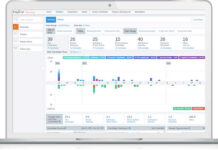
In case there’s any doubt left about the urgent need for mobile and remote HR solutions, Zurich-based International Workplace Group reports that more than 70 percent of employees work outside of their office at least one day a week. Fifty-three percent work remotely for at least half the week, and 11 percent work outside the office a full five days week.
 The trend is global, said IWG CEO Mark Dixon. “People from Seattle to Singapore, London to Lagos no longer need to spend so much time in a particular office.”
The trend is global, said IWG CEO Mark Dixon. “People from Seattle to Singapore, London to Lagos no longer need to spend so much time in a particular office.”
IWG’s study found that employers already recognize that flexible work arrangements pay off in measurable ways. Of the 18,000 businesses it polled across 96 countries, 89 percent said flexible work arrangements had led to higher business growth, 87 percent reported increased competitiveness, 82 percent spoke of rising productivity and 80 percent said retention has increased.
IWG is a provider of flexible workspaces, so it’s no surprise that it’s glad to talk about people getting out of the office. But its report underscores just how wide and deep this tide is. According to the advocacy group 1 Million for Work Flexibility, (1MFWF) the number of people telecommuting in the U.S. alone reached 3.9 million in 2017, equaling 2.9 percent of the workforce and a 115 percent increase since 2005. (The group’s definition of “telecommuting” is “working from home at least half the time.”)
1MFWF, which based its report on data from the Bureau of Labor Statistics, noted that the BLS tracks flexible workplace trends with “with a more rigid standard than public surveys.” Specifically, it only counts companies who offer telecommuting to all or most of their employees. By that standard, only 7 percent of U.S. employers offered telecommuting in 2015. That’s still a notable (40 percent) increase than the number who did in 2010.
Flexibility and Employee Demand
What’s most interesting in all of this is that the average telecommuter is at least 46 years old, has at least a bachelor’s degree and earns more than their in-office colleagues, according to 1MFWF. In addition, most telecommuters hold some kind of management role, although workers in technology, math and military jobs work at home more commonly than professionals in other sectors.
This indicates that it’s not necessarily the Millennials who’ve been the driving force behind the push for flexible work. Or, if they were among the first to sound off on the issue, their voices have been amplified by the rapid adoption of flexible work by their older colleagues.
Also important: According to the marketing firm Fractl, 80 percent of workers said work-from-home options were among the top four most-valued benefits. Interestingly, 88 percent said the same thing about flexible hours. We’ll bet those considerations are linked by the growing belief that work and life shouldn’t be “balanced” so much as “harmonized.”
The growth of the contingent workforce combined with the increasing desire for flexible and remote-work arrangements will undoubtedly push employers and vendors to create new solutions. These tools will allow workers to communicate with HR and access benefits and performance information from a variety of locations using a variety of devices. Dependable connections, consistent user experiences and the ability to simply access information are already expected by most workers. We can see that expectation quickly turning into a demand—one of the core drivers of the purchasing decision.
In the long run, vendors who hold back in areas such as ease-of-use and mobility so they can spend more money on machine learning and other flavors of AI may be shooting themselves in the foot.
Image: Felix_Broennimann / Pixabay















